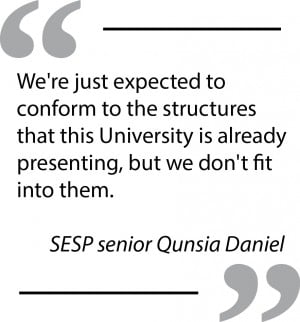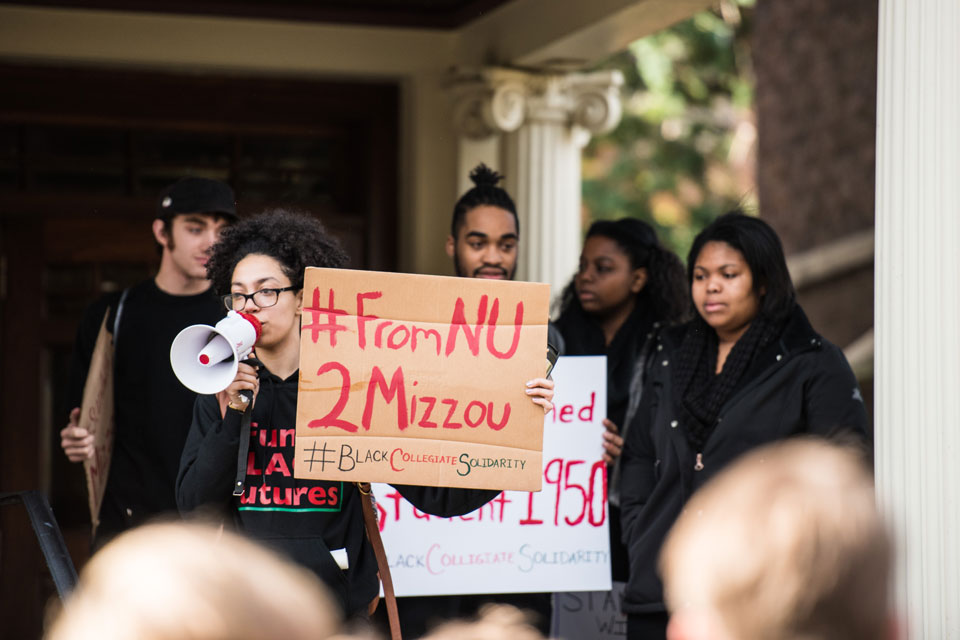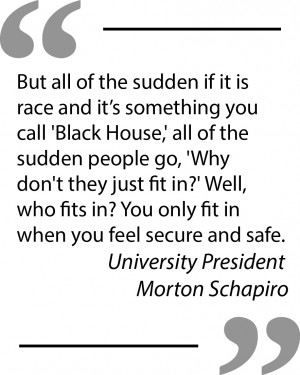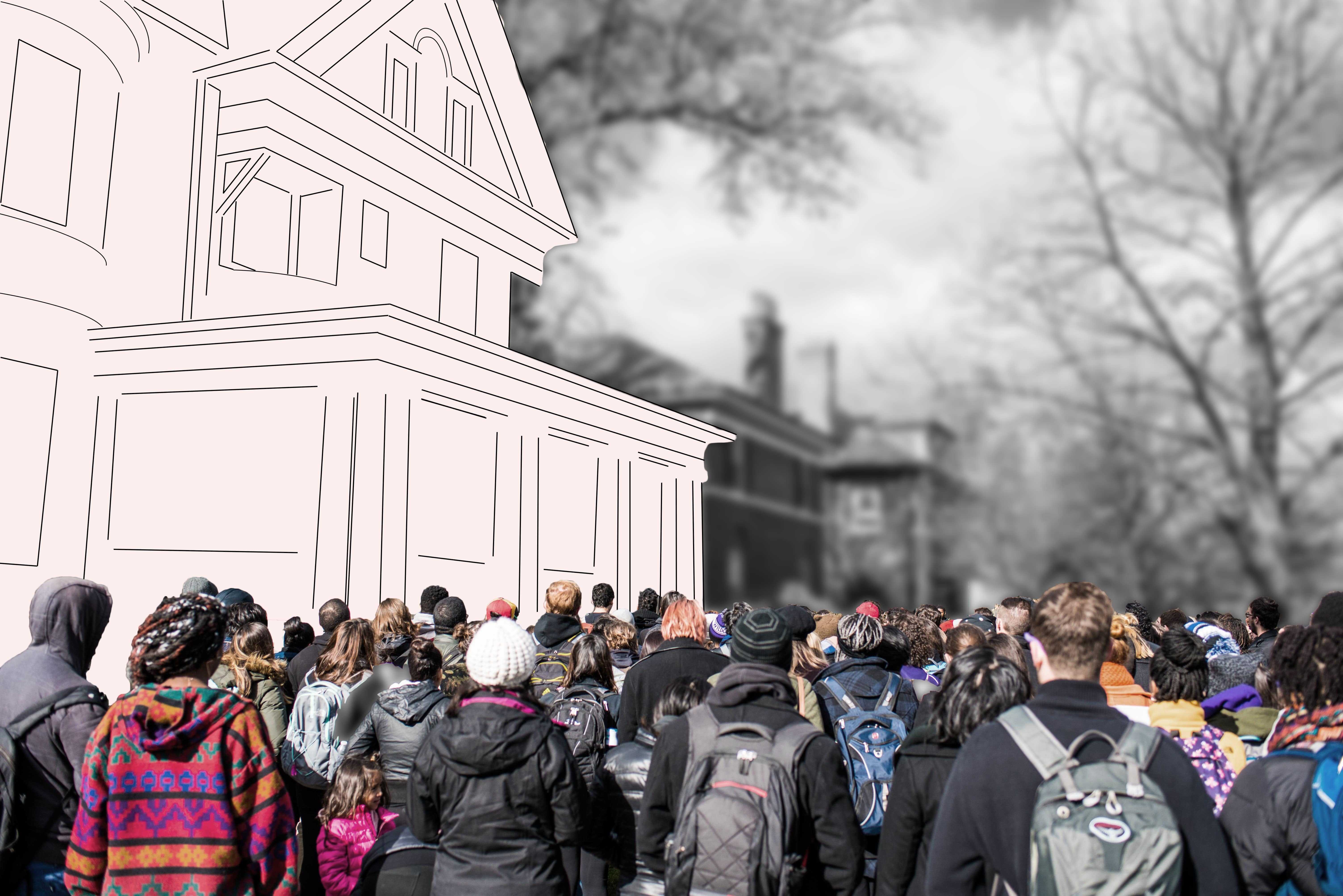In Focus: Searching for safe spaces
Black House controversy ignites debate over safe spaces at Northwestern
February 23, 2016
Surrounded by hundreds of other protesters, Qunsia Daniel marched past security and into the Henry Crown Sports Pavilion basketball courts, surprising an audience of student-athletes, alumni and top University officials.
As Daniel and the other protesters — many of them black Northwestern students like her — engulfed the audience, they rose their fists in the air and chanted, “Power!” Protest leaders took the stage where, minutes before, school administrators had been celebrating the groundbreaking of a new athletic facility.
Chanting into a megaphone, student leaders faced trustees and University officials they said failed to provide them with a safe space on campus. The rest of the student protesters stood in the back, listening intently before leaving the room singing, “You can’t stop the revolution.”
That moment, Daniel said, was exhilarating.
“It would’ve been cool to have heart monitors on everybody — so much unity, and we moved as one body,” the SESP senior told The Daily in the weeks after the protest. “It was just beautiful.”
Two weeks after the protest, students wrote to University President Morton Schapiro demanding changes to University curricula, buildings and demographics to make NU more inclusive for minorities. The demands include removing John Evans’ name from buildings and positions, creating a U.S.-centric inequalities and diversity requirement for all majors and renovating the Black House and the Multicultural Center.
Video by Mariana Alfaro and Bailey Williams/Daily Senior Staffers
Controversy about safe spaces for marginalized communities at NU swept through campus this academic year after the University announced in August plans to move administrative offices into the Black House and the Multicultural Center. The changes would have reduced space for minority student groups that use the buildings, including For Members Only, Alianza, Muslim-cultural Students Association and Asian Pacific American Coalition.
Many students and alumni responded with outrage. Following a quarter of open discussions on campus where people spoke about the importance of the Black House, administrators canceled the changes in November.
During one November discussion, Vice President for Student Affairs Patricia Telles-Irvin was moved to tears after listening to students and alumni describe the Black House’s impact on their NU experience.
 At the end of the session, she told The Daily the concept of a safe space is “very real” and said the University must provide spaces “where students can feel comfortable, validated, where they have a sense of belonging as well as of support.”
At the end of the session, she told The Daily the concept of a safe space is “very real” and said the University must provide spaces “where students can feel comfortable, validated, where they have a sense of belonging as well as of support.”
Although administrators said the original intent behind moving Campus Inclusion and Community offices into the MCC and the Black House was to have campus resources for minority students in a central location, Telles-Irvin said she understood why students wanted their meeting space respected.
The Black House Facility Review Committee, a group of faculty, alumni and students, will submit a report to Telles-Irvin in March with recommendations on how to improve the Black House. Telles-Irvin said renovations to make the Black House and the Multicultural Center more useful, including installing new computers and software, are already underway.
Yet the issue of safe spaces still looms large at NU and on campuses nationwide. There is disagreement about the necessity and definition of safe spaces. Some say universities should give minority students more spaces free of external pressures, while others argue such spaces only coddle students and don’t prepare them for the real world.
At the center of this conversation at NU is the list of demands the student protesters voiced in November.
“We’re just expected to conform to the structures that this University is already presenting, but we don’t fit into them,” Daniel said. “These are the ways the university is unsafe and these are ways that you can fix them, or at least approach it.”
A home on Sheridan Road
Rachel Hampton distinctly remembers the first time she walked into the Black House as a prospective student.
“It was just good to see there was a space for black students on campus,” the Medill junior said. “The first day I remember coming here and realizing how white the class was and how white everyone on campus was and I was like, ‘I don’t know if this is actually the place for me.'”
Upon entering the Black House and walking into its first-floor living room, students are greeted by a colorful painting of different African-American historical figures. Charles Kellom, Multicultural Student Affairs director, has an office at the back of the first floor where students can stop by to chat. The second and third floors offer meeting spaces for student groups.
Hampton laughed as she mentioned the candy that’s become a staple of the building’s lobby, which is where Daphne Nwankpa, Multicultural Student Affairs administrative assistant, used to sit and greet students. The vibe of the Black House community and Nwankpa, who has since moved up to the second floor, made Hampton feel more comfortable at NU during her first visit years ago.
“Knowing that the Black House was here was really important in my decision to actually come here,” she said.
Hampton, who studied abroad last quarter, missed the protest and the discussion sessions about the Black House during the fall but said she was upset by the proposed changes.
She said people have the wrong idea about what students are asking for when they want a safe space, thinking it means a room free of confrontation. To her, a safe space is a place where students can be themselves without the fear of being judged or having to defend themselves.
Timeline by Mariana Alfaro/Daily Senior Staffer
Kellom told The Daily in December that when students say “safe space,” they don’t really mean a place where no one can hurt or challenge them. They mean, he said, a place that is a physical representation of their culture, values, history and people, like the Black House.
“People of targeted identities in American societies in general are required to find or create safe spaces for themselves,” he said. “People with more ardent identities, more privilege, don’t have to consider the fact that the majority of spaces are safe for them already.”
In October, Medill junior Jesse Sparks published a piece in The Spectrum, a forum for marginalized voices in The Daily’s opinion section, about black students feeling they have to act as representatives for their race while in class.
He told The Daily last month that a lot of students of color understand classrooms aren’t always going to be safe spaces. These students have to deal with everyday microaggressions, small comments or actions that unintentionally offend someone’s identity, he said. Although academic settings can sometimes feel unwelcoming to students of color, places like the Black House can provide a home away from home.
“That’s one of the best things about the Black House,” he said. “It’s all the goodness of being in a communal space without trying, without all the worries of ‘Am I doing all social graces? Am I checking all of the boxes? Am I doing all of the pleasantries?’ It’s more just about just being in a space, and it is simple and it is good, and that is enough.”
A national conversation
In a December interview with The Daily and in an op-ed published in The Washington Post last month, Schapiro spoke to the importance of safe spaces.
“You first have to feel safe before you then voluntarily engage in uncomfortable learning, so you need a safe space,” he told The Daily.
uncomfortable learning, so you need a safe space,” he told The Daily.
Schapiro’s op-ed launched NU into the national conversation about safe spaces. The debate picked up speed this school year following protests on campuses nationwide — most prominently at the University of Missouri and Yale University — where students demanded administrative responses to racial incidents on their campuses.
Viral articles like The Atlantic’s “The Coddling of the American Mind” and Vox’s “I’m a liberal professor, and my liberal students terrify me” criticize students who they argue are turning away from any opinion they disagree with.
Emily Jashinsky, a spokeswoman for the Young America’s Foundation, a conservative youth organization based in Virginia, is critical of this safe space movement.
“Unfortunately, the way safe spaces are being used is to protect students from other points of view,” Jashinsky said.
Safe spaces insulate students in a bubble of thought favorable only to their own unchallenged beliefs, Jashinsky said. She said students’ opinions should be constantly challenged. While a student at George Washington University, she said her politically conservative views were often questioned, which helped her strengthen and refine her opinions.
“We talk a lot about diversity on college campuses, but what we totally ignore is diversity of opinion, which is just as important as other kinds of diversity,” she said.
Kellom said people who say minority students calling for safe spaces don’t want to be challenged don’t understand they’re already challenged and uncomfortable “every day, all the time.”
“We exist in a state of being challenged because the society around us is not designed to represent us,” Kellom said. “The institutions, hoping to educate us, are often unintentionally – sometimes intentionally – perpetuating that discomfort and that challenge.”
‘Do I really have to stay for this?’
Earlier this quarter, Hampton was sitting in her 9 a.m. Media Law and Ethics class when a guest speaker played the video of Laquan McDonald’s shooting at least twice for the class.
McDonald, a black Chicago teen fatally shot 16 times in 15 seconds by a white police officer in 2014, made national news after a video of the shooting was released to the public in November 2015, sparking outrage against the Chicago Police Department. For days, the tape played frequently on the news, yet Hampton had purposefully avoided seeing the video.
Hampton said the guest speaker, ABC 7 Chicago reporter Tanja Babich (Medill ‘07), asked students if they had seen the video already. About half the students in class raised their hands before Babich said, “We’re going to watch it now.”
“That was pretty much all the warning we were given,” Hampton said. “We probably had like a minute and a half between she said, ‘We’re going to watch the video’ and the video played so I was kind of like, ‘Should I leave?’ I haven’t seen this video before and there’s a reason I haven’t seen it. Do I really have to stay for this?’”
Babich told The Daily the class had a conversation about the video before watching it and students “had lots of time to either excuse themselves or they would know to look away.”
Hampton said Babich narrated the video very clinically, describing it from the perspective of whether or not ABC 7 should have published it before it was released to the public. Hampton said though she understood why ABC 7 had to show the video on air, she didn’t understand why it was necessary for the video to be shown in the classroom.
“I can’t go home and brush this off,” she said. “This very much affects my life, this is something that could happen to someone I know, this could happen to me. I have to choose basically between being in a class that I’m required to take for my major and leaving class an hour early because I don’t want to see a video.”
Hampton said videos of police shooting black people are being shared more often, removing taboos about showing their deaths online and on TV.
“It is suddenly like this viral video — it’s like torture porn that everyone is just showing,” she said. “I really feel like journalists should analyze why they feel the need to show these videos.”
The incident left Hampton emotionally shaken. However, she didn’t approach her professor, Joe Mathewson, or Babich about it because, as a black student in Medill, she “didn’t feel like being that person” who complained about it.
Hampton said she decided not to speak out because she had no way of knowing how the professor would react. She said she was worried the class might think she was oversensitive and make her explain her emotions.
 At NU, black students make up roughly six percent of the total student population. Hampton said the responsibility to point out microaggressions usually falls on black students, which can be tiring.
At NU, black students make up roughly six percent of the total student population. Hampton said the responsibility to point out microaggressions usually falls on black students, which can be tiring.
Mathewson said no students complained to him about the incident, although some students told The Daily it made them uncomfortable. He said Babich’s presentation was purely educational.
“She’s a TV reporter, she was talking about how the video was discovered and some hesitations on whether it would be shown,” he said. “She was talking about newsroom decisions.”
The release of the McDonald shooting video was probably one of the greatest ethical dilemmas for Chicago journalists in 2015, Babich told The Daily.
“I would be doing the students a disservice by lecturing on media ethics and not bringing up the Laquan McDonald shooting video,” she said.
After hearing about some students’ negative reactions, Babich said she would show the video again but would make sure students were aware they could leave if they didn’t feel comfortable. She said student journalists need to know how to make difficult decisions in the newsroom.
“I would encourage students at this stage of their lives and not later to become comfortable with speaking up if they have concerns or questions about something,” she said. “College is the safest space you can do it in because it only gets harder to speak out after you leave college.”
Safe spaces in the classroom
Trigger warnings — announcements that alert students to potentially uncomfortable topics or subjects — much like the one Hampton said she needed during the class, have also been part of the conversation on safe spaces. In 2015, Communication Prof. Laura Kipnis wrote a piece for The Chronicle of Higher Education criticizing strict policies on relationships between students and professors. The article mentions an instance a student asked her for such a warning.
Noa Wiener, a student who requested a warning in one of Kipnis’ classes, said she believes she is the student Kipnis was referencing.
In April 2014, Wiener (Communication ‘15) emailed Kipnis the night before class telling her she wouldn’t be able to watch a film assigned for homework, “Notes on a Scandal,” a psychological thriller about a relationship between a professor and a student.
“When I was in the class, I had just been diagnosed with a very severe anxiety disorder and was coming out of a very deep depression,” Wiener told The Daily. “We were supposed to watch a movie that had themes I thought were directly related to my anxiety disorder.”
Wiener told Kipnis she began watching the film and became afraid the movie’s romantic relationship involving an adult and a minor would provoke her anxiety.
“If my recovery continues on its current trajectory, I would be able to watch the film without a problem,” she wrote in the email to Kipnis. “It’s just that right now, it would be like going for a swim while you still have the flu.”
Kipnis told Wiener she didn’t have to watch the film but should still come to class to discuss it the next day.
“I was very uncomfortable the whole time. I was digging my fingernails into my arm,” Wiener said. “Had Kipnis said, ‘This is what this movie is going to be about,’ right before, the week previously … it would’ve just given me time to prepare.”
Yet Kipnis told The Daily she doesn’t believe in such warnings because they make students fear the world after college.
“When you get out of school, nobody is going to be there to warn you that something might come up in a film or in TV or in a conversation that you would find upsetting,” Kipnis said. “In a classroom discussion, all sorts of things can come up in conversation and there’s just no way of predicting in advance what could be … ‘triggering’ to someone.”
In a college setting, a trigger warning can be many things, from an email before a lecture to a short description in a syllabus to an announcement made before class. Proponents of trigger warnings say they prepare students, especially those with mental illnesses or who have survived a traumatic experience, to deal with materials that may be troubling.
However, NU’s policies on trigger warnings are vague.
NU uses trigger warnings in some materials sent to the student body, such as the 2015 Campus Climate Survey on Sexual Misconduct sent Spring Quarter, University Provost Daniel Linzer said. He said Title IX training for faculty and staff also contained trigger warnings.
For course materials, however, NU’s current policy gives faculty discretion on framing difficult topics.
“Just as we rely on individual faculty to design what’s the best way to teach the material in your class,” Linzer said, “we do have to rely on the judgment of individual faculty on how do you introduce a difficult topic.”
 Daily file photo by Daniel Tian
Daily file photo by Daniel Tian
Amanda Odasz, communications chair for Sexual Health and Assault Peer Educators, said trigger warnings would give survivors of sexual assault and other trauma a more comfortable classroom space to become involved with difficult conversations.
“If Northwestern wants to say they support survivors, they need to put their actions behind that,” the Communication junior said. “Trigger warnings are an important step.”
The legacy of John Evans
In November, the Native American and Indigenous Student Alliance introduced a petition to have University founder John Evans’ name removed from faculty positions and University buildings, due to his connection to the Sand Creek Massacre, a deadly attack on Native Americans in 1864.
Signers of the petition, which by January had collected more than 300 names, promised to “stand with the students, alumni, faculty, and staff who are marginalized within these spaces,” the petition said.
And although Schapiro said in December that he understands why students feel certain names on University buildings should be changed, he doesn’t believe in “sanitizing history.” Instead, he said, universities should educate students about the history behind the names of buildings, taking into account both their positive and negative aspects.
Medill junior Lorenzo Gudino, NAISA’s treasurer, said although he understands Schapiro’s stance, the names should still be removed.
In the 2014-15 school year, fewer than 10 native students were enrolled at the university. NU has plans to increase enrollment of native students in the coming years, but Gudino said when native students visit and see these names around the university, it brings back trauma that can be triggering.
“It’s not a really safe space for them,” he said. “They still have that historical trauma ingrained with them.”
Schapiro said he doesn’t have the power to make the changes students are requesting. That responsibility lies with the trustees, who he said are discussing removing Evans’ name from buildings and titles.
‘You only fit in when you feel secure and safe’
Those who argue safe spaces “coddle” students of color fail to notice that safe spaces exist for many identities that are not directly tied to skin color, like religion, Schapiro said.
Weinberg senior Mitchell Caminer, Hillel co-president, said if administrators had tried to move additional administrative offices into Hillel like they did to the Black House, it wouldn’t have been well received.
Caminer said even though the concept of safe spaces is trending right now, Hillel has always been a space for Jewish students to feel safe, particularly during the time when NU had quotas for the number of Jewish students it would admit.
“For much of Northwestern’s history, Northwestern has not been a particularly welcoming space for Jewish students,” he said. “It’s changed tremendously in the last 30 to 50 years, and Hillel is one of the reasons that that was able to happen.”
particularly welcoming space for Jewish students,” he said. “It’s changed tremendously in the last 30 to 50 years, and Hillel is one of the reasons that that was able to happen.”
He said Hillel has played such an important role in his NU experience that it was disheartening for him to hear about the planned changes to the Black House and the Multicultural Center, saying it is frustrating that other students don’t have a space like Hillel for their identities.
Schapiro agreed.
“Do you ever notice how no one has a problem with Hillel? Where Jews feel safe? And nobody has problems with the Catholic center — in our case Sheil — where Catholics feel safe,” he told The Daily in December. “But all of the sudden if it is race and it’s something you call ‘Black House,’ all of the sudden people go, ‘Why don’t they just fit in?’ Well, who fits in? You only fit in when you feel secure and safe.”
Those concerned about the infringement of freedom of speech by trigger warnings or safe spaces, Schapiro said, should try to think about students as partners in learning rather than criticize them by calling them “soft” and “fragile.”
“Maybe if we had done a better job as parents and grandparents, maybe your generation wouldn’t need to be shielded,” he told The Daily in October. “But I just hate when people blame the victim. … There are a lot of people who have been traumatized in their lives and to pretend otherwise and to tell them to toughen up like we did, I find that really hard to take.”
Daniel, the student at the protest, said students from traditionally marginalized groups constantly face situations where no one understands their identity. They simply wish to find and deserve a space to feel at rest, she said.
“No one else knows what that feels like except the people who share that same identity,” she said. “You go to the Black House because they know, because you don’t have to explain yourself … it’s me going to a place where I’m safe and my whole identity is respected.”
Photo illustration by Mande Younge/Daily Senior Staffer
Daily file photo by Daniel Tian
Email: [email protected]
Twitter: @marianaa_alfaro

